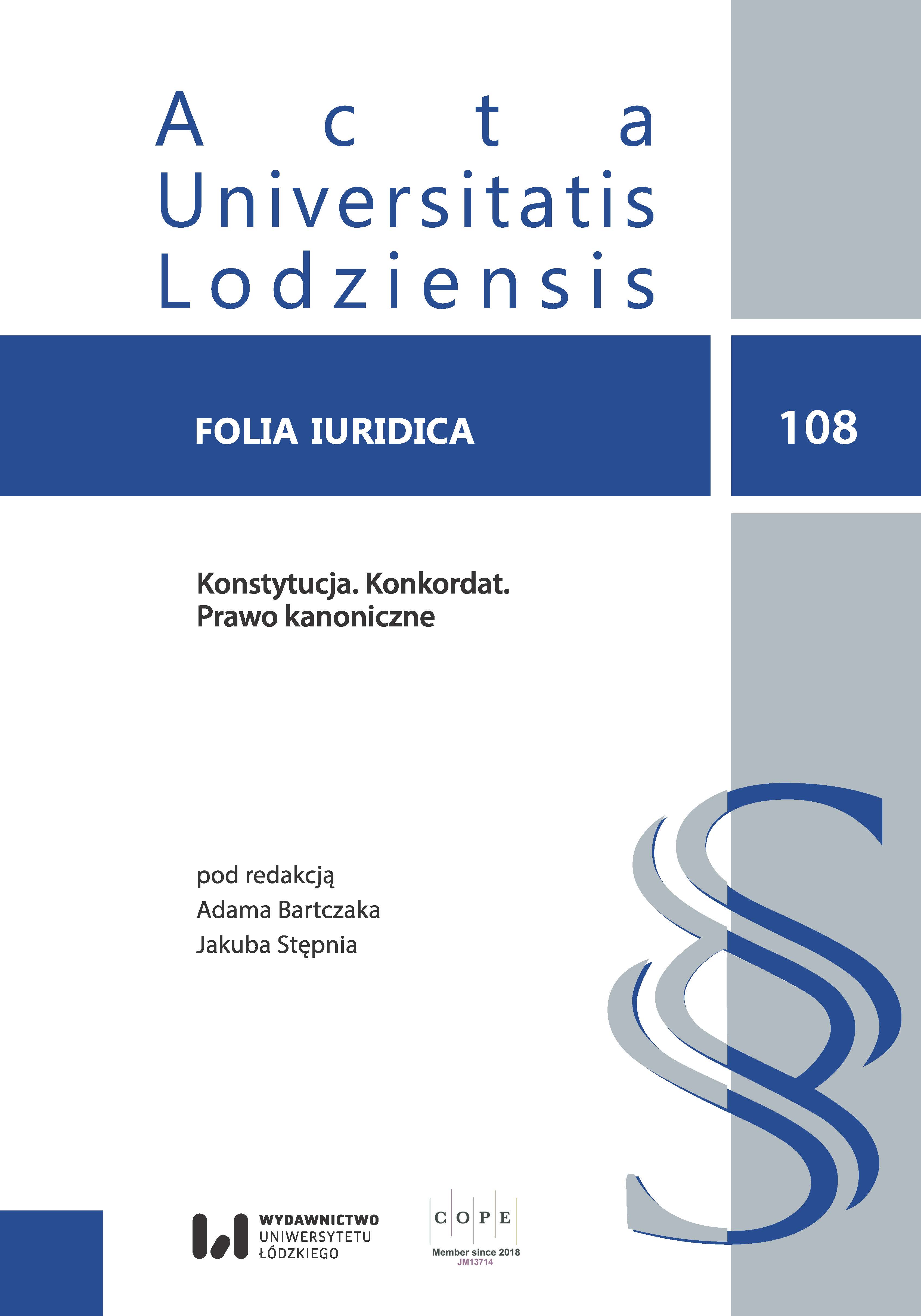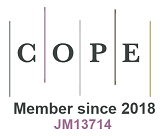Stosunki między Stolicą Apostolską a Litwą: stulecie historii
DOI:
https://doi.org/10.18778/0208-6069.108.07Słowa kluczowe:
Stolica Apostolska, konkordat, litewskie umowy międzynarodowe, traktat międzynarodowy, międzynarodowa podmiotowość prawnaAbstrakt
W artykule zanalizowano stosunki między Stolicą Apostolską a Republiką Litewską od początku niepodległości państwa do dnia dzisiejszego. W pierwszej kolejności autorzy dokonali przeglądu etapów rozwoju tych relacji oraz głównych kwestii prawnych. Następnie w artykule dokonano analizy typowych postanowień konkordatu jako umowy międzynarodowej. Kolejna część artykułu poświęcona jest omówieniu postanowień dotychczasowych czterech umów między Stolicą Apostolską a Litwą, uzupełniając je o porównanie z umowami Stolicy Apostolskiej zawartymi z pozostałymi dwoma krajami bałtyckimi – Łotwą i Estonią. Badanie objęło kwestie prawne współpracy między Stolicą Apostolską a Litwą oraz niektóre aspekty przeplatającego się kontekstu historycznego, politycznego, międzynarodowego i religijnego. Autorzy konkludują, że w złożonym międzynarodowym kontekście politycznym Stolica Apostolska była i pozostaje jednym z najbardziej wiarygodnych partnerów Litwy i jest autorytetem moralnym dla Narodu, którego większość stanowią katolicy. Uznanie Litwy jako państwa wkrótce po ogłoszeniu niepodległości w 1918 r. i nieuznanie jego pięćdziesięcioletniej okupacji znacząco przyczyniły się do przywrócenia niepodległości państwa w 1990 r. Chociaż odrodzenie niepodległego państwa litewskiego oparte na kontynuacji tożsamości państwowej stworzyło przesłanki do obowiązywania od 1927 r. konkordatu zawartego przez Stolicę Apostolską i Republikę Litewską, nie odzwierciedlał on już nowych realiów, ponadto zasadnicze zmiany skłoniły strony do zawarcia nowych umów międzynarodowych. W 2000 r. Stolica Apostolska i Republika Litewska zawarły Umowę o prawnych aspektach stosunków między Kościołem katolickim a państwem, Umowę o współpracy w dziedzinie edukacji i kultury oraz Umowę o katolickim duszpasterstwie wojskowym, a w 2012 r. Umowę o uznawaniu kwalifikacji związanych z wyższym wykształceniem. Te dwustronne porozumienia zawierają postanowienia typowe dla konkordatów, co wynika z ich specyfiki łączenia spraw politycznych (prawnych) i kościelnych oraz zachowania autonomii stron: regulują status prawny Kościoła katolickiego oraz wiele kwestii, w tym instytucjonalne, dotyczące wolności wyznania, edukacji religijnej, życia rodzinnego, ochrony dziedzictwa kulturowego, duszpasterstwa i wiele innych. Postanowienia te są podobne do postanowień zawartych w umowach Stolicy Apostolskiej z dwoma innymi państwami bałtyckimi, Łotwą i Estonią, z których żadne nie ma religii państwowej. Jednak umowy międzynarodowe Stolicy Apostolskiej zawarte odpowiednio z Litwą i Łotwą zawierają więcej bardziej ogólnych i szczegółowych postanowień niż umowa z Estonią; ponadto niektóre kwestie dotyczą tylko konkretnego kraju i dlatego są regulowane jedynie w odniesieniu do niego.
Pobrania
Bibliografia
Aust, Anthony. 2013. Modern Treaty Law and Practice. Cambridge: Cambridge University Press.
Google Scholar
DOI: https://doi.org/10.1017/CBO9781139152341
Balodis, Ringolds. 2019. “State and Church in Latvia.” In State and Church in the European Union. Edited by Gerhard Robbers. 297–324. Baden-Baden: Nomos Verlagsgesellschaft.
Google Scholar
DOI: https://doi.org/10.5771/9783845296265-297
Carulli, Ombretta Fumagalli. 2012. “Concordats as Instruments for Implementing Freedom of Religion.” Pontifical Academy of Social Sciences. Acta 17: 619–627.
Google Scholar
Kasparavičius, Algimantas. 2003. “Lietuvos ir Vatikano santykiai, arba Šventojo Sosto reikšmė tarpukario Lietuvos užsienio politikai.” Lietuvos katalikų mokslo akademijos metraštis. Vilnius 23: 295–379.
Google Scholar
Kiviorg, Merilin. 2010. “Religion and the Secular State in Estonia.” In Religion and the Secular State: National Reports. The International Center for Law and Religion Studies. Edited by Javier Martínez-Torrón, W. Cole Durham. 261–272. Provo, UT: Brigham Young University.
Google Scholar
Krukowski, Józef. 2014. Poland and the Holy See: Contribution to the Concordatory Law. Lublin: Teka Komisji Prawniczej.
Google Scholar
Lynn, Barry W. 2010. “Religion in the Military: Finding the Proper Balance.” In Attitudes Aren’t Free: Thinking Deeply About Diversity in the US Armed Forces. Edited by James E. Parco, David A. Levy. 15–24. Maxwell Air Force Base, AL: Air University Press.
Google Scholar
Mälksoo, Lauri. 2022. Illegal Annexation and State Continuity. Leiden: Brill–Nijhoff. https://doi.org/10.1163/9789004464896_004
Google Scholar
DOI: https://doi.org/10.1163/9789004464896
Maluwa, Tiyanjana. 1987. “The treaty-making capacity of the Holy See in theory and practice: A study of the jus tractum of a non-state entity.” The Comparative and International Law Journal of Southern Africa 20(2): 155–174.
Google Scholar
Salo, Vello. 2002. “The Catholic Church in Estonia, 1918–2001.” The Catholic Historical Review 88(2): 281–292.
Google Scholar
DOI: https://doi.org/10.1353/cat.2002.0103
Agreement between the Holy See and the Republic of Latvia of 8 November 2000. https://likumi.lv/ta/id/66742-par-latvijas-republikas-un-sveta-kresla-ligumu
Google Scholar
Agreement between the Republic of Estonia and the Holy See on juridical status of the Catholic Church in Estonia of 1999. https://www.vatican.va/roman_curia/secretariat_state/1998/documents/rc_seg-st_19981223_santa-sede-estonia_en.html
Google Scholar
Agreement between the Republic of Lithuania and the Holy See on the Recognition of Qualifications Concerning Higher Education of 8 June 2012. Valstybės žinios, 2012, 118–5945. https://www.iuscangreg.it/conc/lituania-2012.pdf
Google Scholar
Agreement between the Republic of Lithuania and the Holy See concerning the Juridical Aspects of the Relations between the Catholic Church and the State of 5 May 2000. Valstybės žinios, 2000, 67–2022. https://www.vatican.va/roman_curia/secretariat_state/2000/documents/rc_seg-st_20000505_santa-sede-lituania-giuridico_en.html
Google Scholar
Agreement between the Republic of Lithuania and the Holy See concerning the Pastoral Care of Catholics Serving in the Army of 5 May 2000. Valstybės žinios, 2000, 67–2023. https://www.vatican.va/roman_curia/secretariat_state/2000/documents/rc_seg-st_20000505_santa-sede-lituania_en.html
Google Scholar
Agreement between the Republic of Lithuania and the Holy See on Co-operation in Education and Culture of 5 May 2000. Valstybės žinios, 2000, 67–2024. https://www.vatican.va/roman_curia/secretariat_state/2000/documents/rc_seg-st_20000505_santa-sede-lituania-cultura_en.html
Google Scholar
Vienna Convention on the Law of Treaties of 1969. United Nations, Treaty Series, Vol. 1155, 331.
Google Scholar
Constitution of the Republic of Lithuania. Valstybės žinios, 1992, 33–1014.
Google Scholar
Law on Education of the Republic of Lithuania. Valstybės žinios, 1991, i.k. 0911010ISTA00I-1489.
Google Scholar
Law on Military Service of the Republic of Lithuania. Valstybės žinios, 1991, 23–593, i.k.0911010ISTA00I-1489.
Google Scholar
Law on Religious Communities and Associations of the Republic of Lithuania. Valstybės žinios, 1995, 89–1985, i.k. 0951010ISTA00I-1057.
Google Scholar
Law on the Protection of Immovable Cultural Heritage. Valstybės žinios, 1995, 3–37, i.k. 0941010ISTA000I-733.
Google Scholar
Act of 16 February 1918 (Resolution of the Council of Lithuania). Constitutional Court of the Republic of Lithuania. Lithuania’s Independence Acts: Act of 16 February. https://lrkt.lt/en/legal-information/lithuanias-independence-acts/act-of-16-february/365
Google Scholar
Act of 11 March on the Re-establishment of the Independent State of Lithuania. Constitutional Court of the Republic of Lithuania. Lithuania’s Independence Acts: Act of 11 March. https://lrkt.lt/en/legal-information/lithuanias-independence-acts/act-of-11-march/366
Google Scholar
Understanding between the Conference of Lithuanian Bishops and the Ministry of National Defence concerning the Ordinariate Regulations of the Lithuanian Army No 140 of 2 August 2022. https://www.ordinariatas.lt/understanding,106.html
Google Scholar
Constitutional Court of the Republic of Lithuania. Ruling of 22 February 2013. Lithuania’s Independence Acts in the jurisprudence of the Constitutional Court. https://lrkt.lt/en/lithuanias-independence-acts/lithuanias-independence-acts-in-the-jurisprudence-of-the-constitutional-court/367
Google Scholar
Constitutional Court of the Republic of Lithuania. Ruling of 18 March 2014. Lithuania’s Independence Acts in the jurisprudence of the Constitutional Court. https://lrkt.lt/en/lithuanias-independence-acts/lithuanias-independence-acts-in-the-jurisprudence-of-the-constitutional-court/367
Google Scholar
Congregation for Catholic Education. 2009. Circular Letter to the Presidents of Bishops’Conferences on Religious Education in Schools. https://www.vatican.va/roman_curia/congregations/ccatheduc/documents/rc_con_ccatheduc_doc_20090505_circ-insegn-relig_en.html
Google Scholar
Council of Europe. 2010. Recommendation CM/Rec(2010)4 of the Committee of Ministers to member states on human rights of members of the armed forces of 24 February 2010. https://search.coe.int/cm/Pages/result_details.aspx?ObjectID=09000016805cf8ef
Google Scholar
Embassy of Lithuania to the Holy See and to the Order of Malta. 2021. Lithuania and the Holy See. https://va.urm.lt/va/en/welcome-to-lithuania/lithuania-ant-the-holy-see
Google Scholar
European Commission. 2022. Eurydice: Estonia. 1. Political, social and economic background and trends. 1.3. Population: demographic situation, languages and religions. https://eurydice.eacea.ec.europa.eu/national-education-systems/estonia/population-demographic-situation-languages-and-religions
Google Scholar
European Commission. 2022. Eurydice: Latvia. 1.Political, social and economic background and trends. 1.3. Population: demographic situation, languages and religions. https://eurydice.eacea.ec.europa.eu/national-education-systems/latvia/population-demographic-situation-languages-and-religions
Google Scholar
Official Statistics Portal. 2021. Results of the 2021 Population and Housing Census of the Republic of Lithuania. https://osp.stat.gov.lt/en/2021-gyventoju-ir-bustu-surasymo-rezultatai/tautybe-gimtoji-kalba-ir-tikyba
Google Scholar
Statistics Estonia. 2021. Population census. The proportion of people with a religious affiliation remains stable, Orthodox Christianity is still the most widespread. https://www.stat.ee/en/news/population-census-proportion-people-religious-affiliation-remains-stable-orthodox-christianity-still-most-widespread
Google Scholar
United Nations Treaty Collection. 2023. Chapter XXIII. Law of Treaties. https://treaties.un.org/Pages/ViewDetailsIII.aspx?src=TREATY&mtdsg_no=XXIII-1&chapter=23&Temp=mtdsg3&clang=_en
Google Scholar
United Nations Treaty Series Online search database. https://treaties.un.org/Pages/UNTSOnline.aspx?id=3&clang=_en
Google Scholar
Pobrania
Opublikowane
Wersje
- 2024-11-29 - (2)
- 2024-11-29 - (1)
Jak cytować
Numer
Dział
Licencja

Utwór dostępny jest na licencji Creative Commons Uznanie autorstwa – Użycie niekomercyjne – Bez utworów zależnych 4.0 Międzynarodowe.













